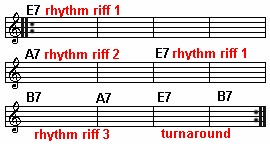Scroll through the lesson and click on notation/video/audio links to load the interactive players.
Please subscribe to get full access to all lessons for only $7.95/month PLUS 1 week free trial.

Riff Interactive lessons are
LESS expensive and
MORE interactive than alternatives!
More Info
|
|

Blues
Guitar For Beginners
Lesson
4 Lesson
Sample
Lyle:
In the last lesson you learned to play the rhythm for a 12 bar blues in E. In
this lesson you'll learn how to play some blues riffs and make a solo for the
same 12 bar blues jam in E.
Lyle: Here's the looping jam track you'll use for
this lesson:
chord
progression

Jam Track in E
Lyle:
The best and easiest scale to use when making blues riffs is the minor
pentatonic scale. It is a 5 tone scale made from the root, b3, 4, 5, and b7
degrees of the major scale. Here's a good pattern to learn for the open E
position:
Em
pentatonic
Lyle:
Practice that pattern ascending and descending, over and over. Make sure you're
using the correct fingers for each of the notes.
Lyle: Here's another pattern that shifts up the
3rd string. I like using this one too:
Em pentatonic - 2
Lyle:
Be sure to click on the TABs and playback so you can see the scales and riffs
layout on the virtual fretboard.
Lyle: Within the minor pentatonic pattern there
are a few notes that are good ones to bend up a whole step (2 frets).
cool notes to
bend
cool notes to
bend
Lyle:
When you bend a note, grab it with a couple fingers to help push or pull the
string. More fingers will give you more strength and
stability.
John:
I can't seem to bend the high string far enough...
Lyle: Use extra fingers to help push the high E
string up. You'll see this technique in the video clip.
Lyle: Now you'll learn a few riffs made from the
minor pentatonic scale, then you'll put them all together to create a simple
solo.
Lyle: Ok, here's your first
riff:
riff
1
riff 1
Lyle:
This first riff uses a slide up and down on the third string. Also notice the
vibrato is used on the notes that are held out/sustained.
Lyle: That is a favorite blues riff of mine. Here
is a variation of the same riff:
riff 2
riff 2
Lyle:
For the next riff you'll do a big bend on the first string. Plant your 3rd
finger on the note and have your 1st and 2nd fingers help push the string
up.
riff 3
riff 3
Lyle:
The next riff is like a combination of the last two
riffs:
riff
4
riff 4
Lyle:
The next blues riff is short and simple, but you have to have control over the
first bent note to be able to hold it in tune:
riff
5
riff 5
Lyle:
All these riffs are used in the solo you heard in the Lesson Sample at the
beginning of this lesson. Here's the final riff:
riff
6
riff 6
Lyle:
Here's how all the riffs are played together to make the solo you hear in the
lesson sample. Notice you'll play riff 3 twice in a row:
solo
Lyle:
Remember to give the held out notes vibrato. This will help the notes sustain.
Plus is gives the riffs some feeling. Here's a video of me playing the whole
solo:
solo
Lyle:
You should try memorizing the whole solo. Each riff can be used in other blues
jams too. Play along to the looping jam track from the beginning of this lesson,
or you can loop the solo TAB, or you can use this jam track that has the solo in
it:
Jam Track with
solo
jerry: Lyle, is
E blues the only scale that fits with this progression?Lyle: Jerry, I only showed the E minor Pentatonic
scale for this 12 bar blues jam in E. There are many other scales you could use.
The easiest is the E minor Pentatonic.
Lyle: Once you have learned the rhythm and the
solo for this 12 bar blues jam in E you should be proud of yourself. It takes a
lot of practice sometimes but very well worth it.
radica: This
had a really nice solo for not being a fast riff type of song. Very
emotive.
Lyle: Time to take a break. As this series of
lessons continue you'll learn other scales and places on the neck to play the
blues. See you next
lesson!
|
<< load notation from left
|
|
<< load audio from left
|
<< load audio from left
|